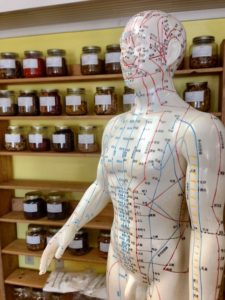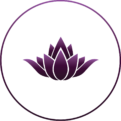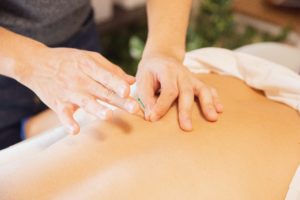What Are They & How Are They Connected?
Reiki… Qi… Meridians… Acupuncture…
The terminology in the world of energy healing can feel overwhelming.
As with anything new, there’s a learning curve to energy healing. But with a little explanation, you’ll soon discover that these concepts are fairly straightforward. And, by the end of this post, you might find that you intuitively know more about energy healing than you may realize.
In this post, we’ll cover:
- Reiki
- Meridians
- Qi
- Acupuncture
These practices, which may seem different, actually share many fundamental similarities.
1. Reiki
Reiki is a form of healing that involves laying on of hands.
The word comes from “rei” meaning spirit or soul and “ki” meaning life energy. “Reiki” then refers to universal life energy. This spiritually guided energy is always available and is able to treat mental, emotional, physical, or spiritual ailments.
Reiki, as it’s practiced today, was established in Japan in the 19th century by Buddhist monk and scholar, Mikao Usui. Later, Ms Hawaiian Hawayo Takata (the first master outside of Japan) spread Reiki in the western world.
How Reiki Works
Reiki activates self-healing powers, releases blockages, regenerates body and mind, and clears thoughts.
Reiki is a gentle healing method using flowing movements. It’s done on the clothed body without any aids (unlike some other forms of massage).
A Reiki practitioner places their hands on or over certain parts of the body and Reiki flows whether hands are directly touching the body or not. Universal life force then flows through the practitioner’s hands, activating the self-healing process. This also loosens blockages to alleviate fears and stress.
Many people report a pleasant warmth during a Reiki treatment, and some fall asleep. The soothing effect of a hands-on treatment is likely innate in humans — like placing a hand on your cheek with a toothache, or pregnant women who intuitively touch their stomach.
Who Is Reiki For?
Reiki is for everyone – infants, teenagers, or adults. It does not require preparation or concentration. If you are open to Reiki’s healing energy, you’ll experience the benefits during a Reiki treatment.
It’s important to know that Reiki applications are not intended to replace medical treatment. No diagnosis is made and no cure is promised. But Reiki can be used in addition to conventional medicine to activate the body’s self-healing ability.
In fact, Reiki is already being used in some hospitals in the U.S. as a complementary treatment. Hospitals in Germany are finding value in Reiki as well. Trials being done show better healing outcomes and hospitals have increased Reiki staff as a result.
2. The Meridians
Meridians are magnetic fields that channel energy in your body. There are 12 of these energetic pathways that run throughout your entire body: from your fingertips to the upper body; from the upper body to the head; from the head to the toes; and from the toes to the upper body. Your meridians connect your top with your bottom and your inside with your outside.
The meridian lines run in mirror images in both halves of the body and are magnetic in nature. Each one has a plus and a minus pole which reverse at sunrise and sunset. The meridians are named after the organs they supply with energy.
These meridians were first discovered and utilized for healing in traditional Chinese medicine. Today they are commonly utilized during acupuncture treatment (see #4 acupuncture below).

3. Qi
Qi (pronounced “chee”) is the life-giving energy that moves through your body.
This is the same kind of energy as the “ki” in Reiki. The most important conductors for the Qi are the twelve main meridians (are you starting to see how these concepts are all connected?)
Remember that the meridian lines run parallel in both halves of your body. Qi energy flows in a certain direction in each half of the body. As Qi cycles throughout the meridians, it ensures Yin and Yang remain in balance.
When Qi flows unhindered and Yin and Yang are in balance, you can remain healthy. But a disruption in Qi energy flow can cause your body to react with symptoms of illness as changes in the balance trigger disease.
4. Acupuncture
Acupuncture is the practice of stimulating Qi throughout the meridians by pressing or sticking needles into the body. The needles are carefully placed along the meridians to stimulate energy flow. This supports the flow of Qi by removing disturbances in the flow of energy that could cause too much or too little Yin or Yang.
The classic acupuncture points are on the twelve main meridians and two additional paths. Originally, there were around 350 acupuncture points, but over time the number has increased to more than the 2,000.
Acupuncture (which is another component of traditional Chinese medicine) is widely practiced today to help heal pain and suffering.
Which Practice Is Right for You?
At their core, these energy practices share many fundamental components.
Learning more about the shared concepts can help empower you to choose the technique that works best for you. Regardless of the modality you choose, you can move further in your healing journey with a broader understanding of how it all works to help you heal.
If you want to move further in your healing journey and be filled with positive energy click below so we can get clear with your goals!
If you would like to have a healing experience of your own with me, book a session here. OR if you would like to learn how to give Reiki to yourself, incorporate a spiritual practice, and have a well-rounded spiritual foundation then fill out the form at the bottom of this page!


